|
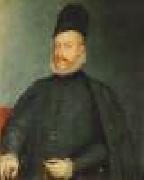 |
SANCHEZ COELLO, Alonso
|
|
Spanish Painter, ca.1531-1588
was a portrait painter of the Spanish Renaissance and one of the pioneers of the great tradition of Spanish portrait painting. Alonso Senchez Coello spent his childhood in Benifair de les Valls, until the death of his father when he was around ten years old. He was educated in Portugal at his grandfather's home. Coello's years in Portugal and his family name of Portuguese origin led to a long-standing belief that he was in fact Portuguese. His grandfather (after whom he was named) was in the service of King John III of Portugal who sent the young painter to study with Anthonis Mor (also known as Antonio Moro) in Flanders around 1550. He was under the service of Antoine de Granville, bishop of Arras, learning from Mor. While studying in Flanders, Coello also spent time copying some of Titian's works. In 1552, the painter went to Lisbon with Anthonis Mor when Charles V commissioned Mor to paint the Portuguese royal family. For a few years, Senchez Coello remained in Portugal working for the court of the heir to the throne, John, Crown Prince of Portugal. After the prince's death, Senchez Coello moved to the Spanish court of Philip II, having been recommended by the widow of John, Juana, who was the sister of the Spanish king. In 1555, S??nchez Coello was in Valladolid working for the Spanish court, and when Mor left Spain in 1561, Senchez Coello took his former master's place as Court Painter. Senchez Coello married Louisa Reyaltes in either 1560 or 1561 in Valladolid, and they had seven children. Coello's daughter, Isabel Senchez (1564-1612), |
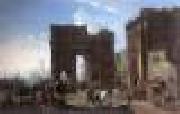 |
SALUCCI, Alessandro
|
|
Italian painter, Roman school (b. 1590, Firenze, d. 1655/60, Roma). Italian painter. He specialized in imaginary architectural perspectives and harbour views, in which the figures were executed by other artists, most notably Jan Miel and Michelangelo Cerquozzi. His pictures were praised by contemporary and near contemporary writers, including Carlo Malvasia, and during the 17th century were popular with private collectors in both Florence and Rome. However, many of the paintings mentioned in contemporary sources remain untraced. He is first documented in Rome in 1628, when, with Andrea Sacchi and Pietro da Cortona, he worked on the fresco decorations of the Villa Sacchetti (now Chigi), Castelfusano (nr Ostia), to which he contributed personifications of the River Nile and the River Rh?ne (in situ). He became a member of the Accademia di S Luca in Rome in 1634, and after 1635 he was engaged on frescoes (in situ) depicting sacred subjects in S Maria in Vallicella, Rome. From the mid-1630s onward Salucci collaborated with Miel on the imaginary architectural subjects for which he is best known, including the Perspective with Portico |
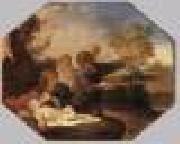 |
SACCHI, Andrea
|
|
Italian painter, Roman school (b. 1599, Nettuno, d. 1661, Roma).Italian painter and designer. He occupied an important position, midway between Annibale Carracci and Carlo Maratti, in the development of a more restrained, less decorative painting in 17th-century Rome, a trend that culminated in the 18th century with Pompeo Batoni. Sacchi trained with Francesco Albani, Carracci's student, and taught Maratti. His often expressed devotion to the art of Raphael and Carracci and his criticism of the views of Pietro da Cortona and Gianlorenzo Bernini made him, with Nicolas Poussin and Alessandro Algardi, one of the most significant representatives of a stylistic and aesthetic opposition to the more flamboyant, extrovert aspects of the High Baroque. Sacchi did not, however, share Poussin's passionate interest in Classical antiquity, nor was his mature work as cerebral. Yet his mature style, less richly coloured than his early manner and more restrained emotionally, |
 |
rudolph von alt
|
|
Rudolf Ritter von Alt (28 August 1812 in Vienna ?C 12 March 1905 in Vienna) was an Austrian landscape and architectural painter. Borne as Rudolf Alt, he could call himself von Alt and bear the title of a Ritter (knight) after he gained nobility in 1882.
He was the son of the famous lithographer Jakob Alt (1789-1872). He studied at the Akademie der bildenden K??nste in Vienna. Hiking-trips through the Austrian Alps and northern Italy awoke a love for landscapes, and he painted with his brush using watercolors in a very realistic and detailed style. In 1833, inspired by a visit to Venice and neighbouring cities, he also made a number of architectural paintings.
Alt demonstrated a remarkable talent for expressing certain peculiarities in nature. He managed to paint nature authentically by focusing on the different hues of sky, the colour-tone of the air and the vegetation. His later works came closer to Impressionism. His perspectives on architecture were interesting, and he often chose everyday objects to paint. The painting of interior-views also became one of his strong points, giving him attention in Vienna.
He visited and worked for a while in Rome and Naples; after that he visited the lakes of Lombardy, then Galicia, Bohemia, Dalmatia, Bavaria and then returned multiple times to Italy. In 1863 he went to the Crimea to paint some views of an estate of the Empress, and in 1867 he went to Sicily.
His younger brother Franz Alt, (b. 1821 in Vienna) was also a painter.
Most of his paintings are held by various museums in Vienna. The Albertina in Vienna hosted a retrospective exhibition from September 2005 to January 2006.
|
 |
Rudolf von Alt
|
|
(28 August 1812 in Vienna C 12 March 1905 in Vienna) was an Austrian landscape and architectural painter. Borne as Rudolf Alt, he could call himself von Alt and bear the title of a Ritter (knight) after he gained nobility in 1882.
He was the son of the famous lithographer Jakob Alt (1789-1872). He studied at the Akademie der bildenden K??nste in Vienna. Hiking-trips through the Austrian Alps and northern Italy awoke a love for landscapes, and he painted with his brush using watercolors in a very realistic and detailed style. In 1833, inspired by a visit to Venice and neighbouring cities, he also made a number of architectural paintings.
Alt demonstrated a remarkable talent for expressing certain peculiarities in nature. He managed to paint nature authentically by focusing on the different hues of sky, the colour-tone of the air and the vegetation. His later works came closer to Impressionism. His perspectives on architecture were interesting, and he often chose everyday objects to paint. The painting of interior-views also became one of his strong points, giving him attention in Vienna. |
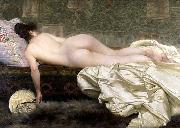 |
Rodolfo Amoedo
|
|
(born in Salvador, Bahia on December 11, 1857; died in Rio de Janeiro on May 31, 1941) was a Brazilian history painter. He began his career as an artist in 1873 as a student of Victor Meirelles. In 1878 he won the first prize at the Brazilian Academy, which allowed him to travel to Paris, where he lived from 1879 to 1887 studying at the École des Beaux Arts. He was a pupil of Alexandre Cabanel and also worked with Paul-Jacques-Aime Baudry. He was a professor and later director of the Brazilian Academy, renamed School of Fine Arts ou Escola Nacional de Belas Artes at the fall of the Brazilian Empire. His students include Eliseu Visconti. He died forgotten and so poor his friends had to help the widow pay for his funeral. His paintings still hang at the National Museum Museu Nacional de Belas Artes in Rio de Janeiro. |
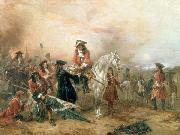 |
Robert Alexander Hillingford
|
|
(1825-1904) was an English painter. He specialized in historical pictures, often battle scenes.
Contents
He was born in London on January 28, 1828, and studied in Desseldorf in 1841 for five years and before traveling to Munich, Rome, Florence and Naples, where he married and worked for several years, producing paintings of Italian life. One painting from this period entitled The Last Evening of the Carnival was exhibited at St. Petersburg in 1859. He returned to London in 1864, and first exhibited at the Royal Academy in 1866; it was at this time that he began to work on historical subjects, especially of the Napoleonic Wars. He was a regular exhibitor at the Royal Academy, British Institution and at other galleries. While he was attracted to costume pieces such as An incident in the early life of Louis XIV and During the wanderings of Charles Edward Stuart', he also included some contemporary military scenes including his 1901 RA painting South Africa, 1901 - The Dawn of Peace.
Wellington at Waterloo
Lord Hill invites the last remnants of the French Imperial Guard to surrenderThe original paintings often come up at auction, and, with a large amount of the collection dispersed in 1998, the original paintings are widely scattered.
|
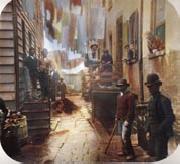 |
Riis Jacob August
|
|
Danish-American journalist and social reformer.
b.1849 d.1914
American photographer of Danish birth. The son of a school-teacher and editor, he was well-educated when he came to the USA in 1870. He was a self-taught photographer and worked at a variety of jobs before becoming a journalist, and he understood the power of the written and illustrated word. Riis's work in journalism began in 1873 when he was employed by the New York News Association. By 1874 he was editor and then owner of the South Brooklyn News. |
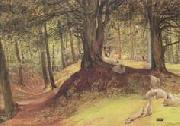 |
Richard Redgrave,RA
|
|
1804-1888
Painter, etcher and administrator, brother of (1) Samuel Redgrave. He trained initially as a clerk and draughtsman in his father's counting-house before becoming a student at the Royal Academy Schools in 1826; he also studied with John Powell. About 1830 he left his father's firm and supported himself as a drawing-master, working in watercolour before attempting to paint in oil. He exhibited at the Royal Academy from 1825 until failing eyesight afflicted him in 1883. He was elected ARA in 1840 and RA in 1851. |
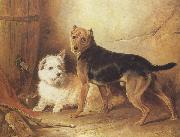 |
Richard ansdell,R.A.
|
|
1815-1885
English painter. He was the son of an artisan and in 1835 entered the Liverpool Academy Schools, where he later became president (1845-6). One of his earliest and largest dated works is the Waterloo Coursing Meeting (1.4*2.4 m, 1840; Liverpool, Walker A.G.). This canvas demonstrates his considerable skill as a portrait painter and creates a detailed record of a major sporting event of the period which was attended by many members of the local aristocracy, some of whom, notably the 3rd Earl of Sefton, were his patrons. It was engraved and published in 1843, and other works were similarly popularized. Shooting Party in the Highlands (1840; Liverpool, Walker A.G.) was the first of 149 works exhibited at the Royal Academy. It shows huntsmen with their horses and dogs resting after a good day's sport, a theme that Ansdell often depicted. He also portrayed other rural scenes such as gamekeepers or shepherds with domestic and wild animals, often in historical settings. All are painted with precision and sensitivity and without sentimentality. Although based in London from 1847 until 1884, Ansdell owned houses in Lancashire and Scotland and found inspiration in northern landscape. He travelled to Spain with the painter John Phillip in 1856 and alone in 1857 and produced several works of Spanish inspiration, for example Feeding Goats in the Alhambra (Preston, Harris Mus. & A.G.). He also collaborated with William Powell Frith and Thomas Creswick in rural genre scenes. Ansdell was commercially successful and was elected ARA in 1861 and RA in 1870. |
 |
Reza Abbasi
|
|
(1565 - 1635) was the most renowned Persian miniaturist, painter and calligrapher of the Isfahan School, which flourished during the Safavid period under the patronage of Shah Abbas I.
He is considered to be one of the foremost Persian artists of all time. He received his training in the atelier of his father, Ali Asghar, and was received into the workshop of Shah Abbas I at a young age.
At the age of about 38 he received the honorific title of Abbasi from his patron, but soon left the Shah's employ, apparently seeking greater freedom to associate with simple people. In 1610 he returned to the court and continued in the employ of the Shah until his death.
His specialty was the Persian miniature, with a preference for naturalistic subjects often portrayed in an effeminate and impressionistic manner,a style which came to be popular during the late Safavid court. |
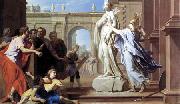 |
Rene-Antoine Houasse
|
|
(c. 1645 - 1710) was a decorative French painter.
He was a pupil of Charles Le Brun, under whose direction he worked at the Manufacture des Gobelins, and with whom he worked on the decoration of the Château de Versailles. He was the director of the French Academy in Rome from 1699 to 1704. His son was Michel-Ange Houasse, a painter of genre scenes.
|
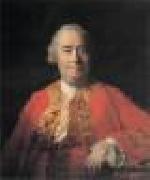 |
RAMSAY, Allan
|
|
Scottish Rococo Era Painter, 1713-1784
Portrait painter, born in Edinburgh, son of the poet Allan Ramsay. He studied in Edinburgh, London, Rome, and Naples, settling in London in 1739 and quickly establishing himself as the leading portraitist of the capital. He was particularly successful in painting women. His career as a portrait painter ended in 1773 |
 |
Ramon marti alsina
|
|
Spanish , 1826-1894
He studied in Paris in successive stages over which he came to know the work of Courbet, the French Realists and the Barbizon school. In the end he even adapted to Impressionism. He is considered the best representative of Spanish Realism.. |
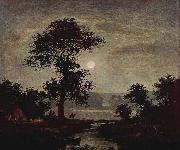 |
Ralph Albert Blakelock
|
|
(October 15, 1847 - August 9, 1919) was a romanticist painter from the United States.
Ralph Blakelock was born in New York City on October 15, 1847. In 1864, Blakelock entered the Free Academy of the City of New York (now known as the City College) with aspirations of becoming a physician. After his third term he opted to dismiss his formal education and left college. From 1869-71 he traveled west, extensively wandering far from known civilization and spending time among the American Indians. Largely self-taught as an artist, he began producing competent landscapes, depicting select views from his travels, as well as scenes of American Indian life. His works were exhibited in the National Academy of Design.
Moonlight, 1885, the Brooklyn MuseumIn 1877 Blakelock married Cora Rebecca Bailey; they had nine children. In art, Blakelock was a genius, yet, in business dealings and in monetary transactions he proved a failure. He found it difficult, if not crushing to maintain and support his wife and children. In desperation he found himself selling his paintings for extremely low prices, far beneath their known worth. In hopes of lifting his family from abject poverty, reportedly on the day his 9th child was born, Blakelock had offered a painting to a collector for $1000. The collector made a counter offer and after refusing the proposed sum Blakelock found himself in a bitter argument with his wife. After the domestic dispute, Blakelock returned to the patron and sold the painting for a much lesser sum. Defeated and frustrated, it is said he broke down and tore the cash into pieces. And so it was after such repeated failed business transactions that he began to suffer from extreme depression and eventually show symptoms of mental frailty. In 1899 he suffered a breakdown. |
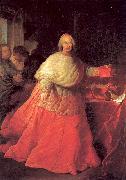 |
Procaccini, Andrea
|
|
Italian, 1671-1734
Italian painter, draughtsman and architect. A pupil of Carlo Maratti, he is first documented in 1702, among the restorers of Raphael's fresco decorations (1511-14) in the Vatican. His Tarquinius and Lucretia (c. 1705; Holkham Hall, Norfolk) has cold colours and unnatural gestures that recall Guido Reni. Appointed by Pope Clement XI, between 1710 and 1717 Procaccini supervised the tapestry factory in S Michele a Ripa: the Purification of the Virgin (Rome, Vatican, Consistory Hall) is the only extant tapestry made from a cartoon (untraced) by Maratti and an oil painting (untraced) by Procaccini. The Baptism of Cornelius Centurion (1711; Urbino, S Francesco) for the Baptism Chapel in St Peter's, Rome, was previously attributed to Maratti or Giuseppe Bartolomeo Chiari, but Procaccini apparently based it on sketches supplied by Maratti, who also supervised and revised the work before it was displayed. |
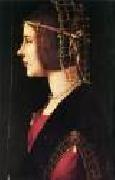 |
PREDIS, Ambrogio de
|
|
Italian Early Renaissance Painter, ca.1455-1508
Painter and illuminator, half-brother of Cristoforo de Predis. He began his career as an illuminator, working with Cristoforo. His first documented works are seven miniatures for a Book of Hours (1472; destr.) for Vitaliano Borromeo (1451-95) and a Book of Hours for Francesco Borromeo. He was paid for the latter in 1474, and the codex can probably be identified with the Horae Beatae Virginis Mariae (ex-H. P. Kraus, New York, 1987; Suida, 1959). From 1479 he artist worked in the Milanese mint, together with his brother Bernardino. For some years Giovanni Ambrogio also worked at the court of Ludovico Sforza ('il Moro'), especially as a portrait painter. This is borne out by the charcoal drawing of Bianca Maria Sforza (1492; Venice, Accad.), which dates from a period before her marriage to Emperor Maximilian I. The portrait was ordered by her future husband, through Frederick III, Duke of Saxony, to give him an idea of her appearance. It was favourably received, and later a painting of the same subject (Washington, DC, N.G.A.) was commissioned from Giovanni Ambrogio. |
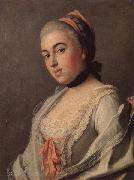 |
Pietro Antonio Rotari
|
|
Italian painter , (b. 1707, Verona, d. 1762, St. Petersburg)
Italian painter. His artistic career began as a youthful distraction, but his talent quickly became apparent, and he entered the studio of Antonio Balestra in Verona, remaining there until he was 18. He spent the years 1725-7 in Venice and then moved c. 1728 to Rome, where he stayed for four years as a student of Francesco Trevisani. Between 1731 and 1734 he studied with Francesco Solimena in Naples before returning to Verona, where he set up his own studio and school. His most notable early independent works are multi-figured altarpieces (e.g. the Four Martyrs, 1745; Verona, church of the Ospedale di S Giacomo), which emulate 17th-century Roman and Neapolitan works. However, he also studied the smaller, more intimate paintings of Roman Baroque artists, and these influenced his later works. He fell victim to the wanderlust that appears to have been endemic to 18th-century Venetian painters, and c. 1751 he travelled to Vienna, where he was able to study works by Jean-Etienne Liotard, whose clean pictorial smoothness impressed him. He later moved to Dresden |
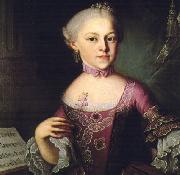 |
Pietro Antonio Lorenzoni
|
|
Pietro Antonio Lorenzoni (1721 - 1782) was an Italian painter who is believed to have painted several portraits of Wolfgang Amadeus Mozart and his family: "The Boy Mozart" (1763), his sister Maria Anna Mozart in "Nannerl as a Child" (1763) and a portrait of their father Leopold Mozart (c. 1765). He arrived in Salzburg, Austria in the 1740s and first wanted to paint Wolfgang and Nannerl. His protege, Johann Nepomuk della Croce, painted a Mozart family portrait in 1780. |
 |
Pieter van Aelst
|
|
(August 14, 1502 - December 6, 1550) was a Flemish painter. He studied under Bernaert van Orley and later lived in Italy before entering the Antwerp Guild of painters in 1527. In 1533, he travelled to Constantinople for one year in a failed attempt to establish business connections for his tapestry works. Van Aelst established a studio in Brussels in 1544, where he created paintings and tapestries. His students include Gillis van Coninxloo, Willem Key, Hans Vredeman de Vries, Michiel Coxcie, and possibly Pieter Brueghel the Elder, who did eventually marry van Aelst's daughter, Mayken. His second wife, Mayken Verhulst, was an artist as well, and, according to Carel van Mander, the first teacher of her grandchildren, Pieter Brueghel the Younger and Jan Brueghel the Elder. He was also the uncle of Joachim Bueckelaer. Van Aelst's studio is also well known for its engraved works.
In particular, van Aelst is noted for his 1539 translation of Sebastiano Serlio's architectural treatise, Architettura, which is credited with having played a crucial role in spreading Renaissance ideas to the Low Countries and hastening the transition from the late Gothic style prevalent in the area at the time. He was in charge of the spectacular decorations for the 1549 Royal entry into Antwerp of Philip II of Spain, "the most famous entry of the century", according to Roy Strong.
|
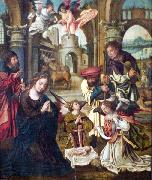 |
Pieter Coecke van Aelst
|
|
(August 14, 1502 - December 6, 1550) was a Flemish painter. He studied under Bernaert van Orley and later lived in Italy before entering the Antwerp Guild of painters in 1527. In 1533, he travelled to Constantinople for one year in a failed attempt to establish business connections for his tapestry works. Van Aelst established a studio in Brussels in 1544, where he created paintings and tapestries. His students include Gillis van Coninxloo, Willem Key, Hans Vredeman de Vries, Michiel Coxcie, and possibly Pieter Brueghel the Elder, who did eventually marry van Aelst's daughter, Mayken. His second wife, Mayken Verhulst, was an artist as well, and, according to Carel van Mander, the first teacher of her grandchildren, Pieter Brueghel the Younger and Jan Brueghel the Elder. He was also the uncle of Joachim Bueckelaer. Van Aelst's studio is also well known for its engraved works.
In particular, van Aelst is noted for his 1539 translation of Sebastiano Serlio's architectural treatise, Architettura, which is credited with having played a crucial role in spreading Renaissance ideas to the Low Countries and hastening the transition from the late Gothic style prevalent in the area at the time. He was in charge of the spectacular decorations for the 1549 Royal entry into Antwerp of Philip II of Spain, "the most famous entry of the century", according to Roy Strong.
|
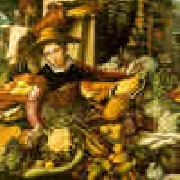 |
Pieter Aertsen
|
|
1508-1575
Flemish
Pieter Aertsen Galleries
Dutch painter and draughtsman, active also in the southern Netherlands. He probably trained in his native Amsterdam but early on moved to Antwerp, where he enrolled in the Guild of St Luke as a master in 1535. In 1542 he was granted citizenship of the city. Among his pupils in Antwerp were Johannes Stradanus and later Joachim Beuckelaer, a cousin of the artist wife and his most loyal follower. The earliest known work by Aertsen is a triptych with the Crucifixion (c. 1545-6; Antwerp, Maagdenhuismus.) for the van den Biest Almshouse in Antwerp. From 1550 Aertsen development can be traced through a large number of signed and dated paintings. Religious works, mostly intended for churches, must have formed an important part of Aertsen output. His early paintings seem to have been strongly influenced by other Antwerp artists, as can be seen in the van den Biest triptych, where the figures are close to those in Jan Sanders van Hemessen background scenes. Van Hemessen influence is also strong in the pair of triptychs showing the Seven Sorrows of the Virgin and the Seven Joys of the Virgin (the latter dated 1554; both Zoutleeuw, St Leonard).
|
 |
Pierre-Auguste Renoir
|
|
French Impressionist Painter, 1841-1919
French painter, printmaker and sculptor. He was one of the founders and leading exponents of IMPRESSIONISM from the late 1860s, producing some of the movement's most famous images of carefree leisure. He broke with his Impressionist colleagues to exhibit at the Salon from 1878, and from c. 1884 he adopted a more linear style indebted to the Old Masters.
His critical reputation has suffered from the many minor works he produced during his later years. |
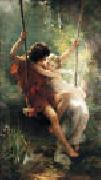 |
Pierre-Auguste Cot
|
|
French
1837-1883
Pierre-Auguste Cot Locations
He was born in B??darieux, and initially studied at l Ecole des Beaux-Arts in Toulouse before going to Paris. He studied under Leon Cogniet, Alexandre Cabanel and William-Adolphe Bouguereau. From the 1870s, his popularity grew quickly. In 1874 he was made Chevalier of the Legion of Honour. He created several works of lasting popularity, including Le Printemps, featuring two young lovers sitting upon a swing, and The Storm. Both these paintings were until recently on display at the Metropolitan Museum of Art in New York City; The Storm belongs to the museum while Le Printemps is owned privately.
Cot also was renowned for his portraits, which made up the majority of his work. The more enduring figurative work, such as The Storm, is comparatively rare. |
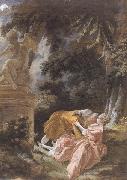 |
Pierre-Antoine Baudouin
|
|
French Painter, 1723-1769
French painter. A pupil of Francois Boucher, whose younger daughter he married in 1758, he specialized in miniatures painted in gouache, which he first exhibited at the Salon of 1761. He was received as a member of the Acad?mie Royale in 1763 with a small gouache of a historical subject, Phryne Accused of Impiety before the Areopagite (Paris, Louvre), and he later painted illustrations of biblical episodes. However, he made his name as a painter of libertine scenes in contemporary settings, which he exhibited regularly at the Salon from 1763 until 1769. Some of his work is directly inspired by Boucher's scenes of pastoral love, but the ostensibly moral themes and careful attention to detail of such paintings as the Modest Model (exh. Salon 1769; Washington, DC, N.G.A.) demonstrate that he was also influenced by Jean-Baptiste Greuze. His pictures were condemned for their immorality, both by the Archbishop of Paris, who in 1763 and 1765 ordered that works by Baudouin be withdrawn from the Salon, and also by Denis Diderot and other critics who accused him of pandering to the decadent taste of his patrons. Nevertheless, Baudouin was one of the most popular artists of the last decades of the ancien regime. |
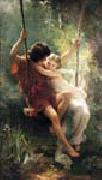 |
Pierre Auguste Cot
|
|
(February 17, 1837 ?C 1883) was a French painter of the Academic Classicism school.
He was born in B??darieux, and initially studied at l'Ecole des Beaux-Arts in Toulouse before going to Paris. He studied under Leon Cogniet, Alexandre Cabanel and William-Adolphe Bouguereau. From the 1870s, his popularity grew quickly. In 1874 he was made Chevalier of the Legion of Honour. He created several works of lasting popularity, including Le Printemps, featuring two young lovers sitting upon a swing, and The Storm. Both these paintings are on display at the Metropolitan Museum of Art in New York City; |
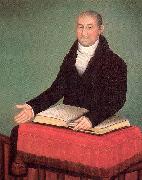 |
Phillips, Ammi
|
|
American Folk Artist, 1788-1865
American painter. Apparently self-taught, he began his prolific and successful career as a portrait painter c. 1811. During his lifetime, he moved several times across the borders of New York, western Connecticut and Massachusetts in search of commissions. Like many of the itinerant artists of the 19th century, he struggled to achieve pictorial solutions and a distinctive style, yet he developed so dramatically that historians originally classified his paintings as the work of two different artists: 'The Border Limner' and 'The Kent Limner'. The earliest works, from his 'Border' period (c. 1812-19), are marked by simple forms, shaded outlines and soft, pastel colours. They include ambitious full-length portraits as well as three-quarter and bust-length examples (Dr Russell Dorr, c. 1814-15; Williamsburg, VA, Rockefeller Flk A. Col.). In the 1820s he experimented with techniques and formats, developing an attention to detail and naturalism that suggests the influence of Albany portrait painter Ezra Ames. By the 1830s, the decade of his 'Kent' portraits, his compositions present his sitters as large, stylized shapes that nearly fill the canvas, while his use of rich, saturated colours creates striking contrasts of light and dark. Typically in this decade, his female sitters are shown leaning forward while male sitters sit upright with one hand draped over a chairback. Among his most appealing and successful works are portraits of children from this period. Blond Boy with Primer, |
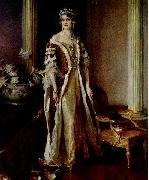 |
Philip Alexius de Laszlo
|
|
Philip Alexius de Laszlo, MVO (30 April 1869 Budapest - 22 November 1937 London) was a Hungarian painter known particularly for his portraits of royal and aristocratic personages.
Laszlo was born in Budapest as Laub Fulop Elek (Hungarian style with the surname first), the eldest son of a Jewish tailor. The family changed its name to Laszlo in 1891.
As a young man, Laszlo apprenticed to a photographer while studying art, eventually earning a place at the National Academy of Art, where he studied under Bertalan Szekely and Karoly Lotz. He followed this with studies in Munich and Paris. Laszlo's portrait of Pope Leo XIII earned him a Grand Gold Medal at the Paris International Exhibition in 1900.
In 1903 Laszlo moved from Budapest to Vienna. In 1907 he moved to England. He remained based in London for the rest of his life while traveling the world to fulfill commissions.
Laszlo's patrons awarded him numerous honors and medals. In 1909 he was named an honorary Member of the Royal Victorian Order by King Edward VII of the United Kingdom. In 1912 he was ennobled by King Franz Joseph of Hungary; his surname became "Laszlo de Lombos". The family later shortened the name to "de Laszlo".
Laszlo became a British citizen in 1914 but was interned for over twelve months in 1917 and 1918 during the First World War.
|
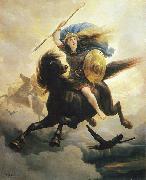 |
Peter Nicolai Arbo
|
|
(June 18, 1831 - October 14, 1892) was a Norwegian painter, who specialized in painting motifs from Norwegian history and images from Norse mythology. He is above all noted for Åsgardsreien, a dramatic motif based on a Norwegian folk legend and Valkyrie, which depicts a female figure from Norse mythology.
Peter Nicolai Arbo grew up at Gulskogen Manor in Gulskogen, a borough in Drammen, Norway. He was the son of headmaster Christian Fredrik Arbo (1791-1868) and his wife Marie Christiane von Rosen. His brother Carl Oscar Eugen Arbo was a military medical doctor and a pioneer in Norwegian anthropologic studies. Arbo's childhood home, Gulskogen, was built in 1804 as a summer residence for his older cousin, lumber dealer and industrialist Peter Nicolai Arbo.Arbo started his art education with a year at the Art School operated by Frederick Ferdinand Helsted (1809-1875) in Copenhagen 1851-1852. After this, he studied at the art academy in Dusseldorf. From 1853 to 1855 he studied under of Karl Ferdinand Sohn, professor of The Dusseldorf School of Art, and from 1857-1858 under J. E. Henthen who was a battle and animal painter. At Dusseldorf he was for some time a private student of the history painter C. Mengelberg. He had contact with Adolph Tidemand and became a good friend of Hans Gude both of whom were professors at the art academy in Dusseldorf. |
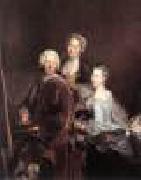 |
PESNE, Antoine
|
|
French painter (1683-1757)
French painter active in Prussia. He studied with his father, the portrait painter Thomas Pesne (1653-1727), and with his maternal great-uncle, Charles de La Fosse. In 1703, as a pupil at the Academie Royale, he would have won the Prix de Rome with his Moses and the Daughters of Jethro (untraced), had not Jules Hardouin Mansart, adviser to the Academie, deemed all entries that year unworthy. Nevertheless Pesne left for Italy, making the acquaintance of Jean Raoux in Venice and being allowed the use of a studio in Rome by Charles Porson, Director of the Academie de France. While in Venice, Pesne painted the portrait of Friedrich Ernst von Knyphausen |
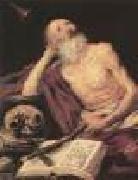 |
PEREDA, Antonio de
|
|
Spanish Baroque Era Painter, ca.1611-1678
Spanish painter. He was the son of a minor painter of the same name (d 1622) and, after his father died, about 1627 he moved to Madrid with his mother. There he entered the studio of Pedro de las Cuevas, and his fellow pupils included such artists as Juan Carreeo de Miranda, Francisco Camilo, Jusepe Leonardo and Antonio Arias Fernendez. He must also have known and studied the work of many masters esteemed at court, particularly Vicente Carducho, echoes of whose work can be found in the former's early paintings. Pereda received protection early on from a member of the Royal Council, Francisco de Tejada, and later from Giovanni Battista Crescenzi, a painter and patron who was in Spain from 1617. Pereda probably completed his training through contact with Crescenzi's collection and eventually he lived in Crescenzi's house. In 1634 Pereda executed Aid to Genoa (Madrid, Prado) for the decoration of the Salen de Reinos in the Casen Buen Retiro, Madrid, a project involving all the leading artists of Madrid, including Carducho, Velezquez, Zurbaren and Jose Leonardo. The death of Crescenzi in 1635 deprived Pereda of further court commissions and seems to have stopped him painting any further secular works other than still-lifes. Also in 1635 he began a well-documented career as a religious painter, producing large altar paintings and many other medium-sized works, probably for private worship. Outstanding among these is the Immaculate Conception (1637) in the Convento de los Felipenses, Alcale de Henares (Madrid). The important allegorical painting Vanitas |
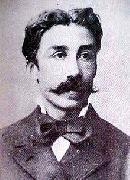 |
Pedro Americo
|
|
de Figueiredo e Melo (Areia, Brazil, 29 April 1843 - Florence, Italy, 7 October 1905) was one of the most important academic painters of Brazil. He was also a writer and a teacher.
He moved to Rio de Janeiro in 1854, where he was granted a scholarship to study in the Academia Imperial de Belas Artes (Imperial Academy of Fine Arts). Later he furthered his studies in Europe, at the École des Beaux-Arts in Paris, being a pupil of Jean-Auguste-Dominique Ingres, Hippolyte Flandrin and Carle-Horace Vernet, winning much praise for his paintings, and achieving the Doctorate in Sciences at the University of Brussels, in 1868.
Returning to Brazil, he produced a great series of masterpieces, including one of the most well known works of art in Brazil: Independence or Death!, depicting the moment when Prince Peter declared the country independent from Portugal, a work that has illustrated History books for elementary schools in Brazil for decades. Living mostly in Florence, Italy but traveling extensively back and forth from Rio de Janeiro, Pedro Am??rico managed to work also as a lecturer and an art historian.
He married Carlota de Ara??jo Porto-alegre (1844?C1918), daughter of painter and diplomat Manuel de Ara??jo Porto-alegre, and they had children. Knighted by the German Crown he was also Great Knight of the Order of the Holy Sepulchre. With the proclamation of the Republic in Brazil in 1889, he was elected a deputy of the National Assembly.
|
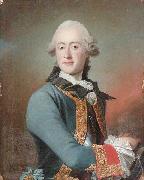 |
Peder Als
|
|
Peder Als, a Danish historical and portrait painter, born at Copenhagen in 1725, studied for some time under C. G. Pile. After gaining the first great prize given by the academy at Copenhagen in 1755, he went to Rome and entered the school of Mengs. He occupied himself chiefly in copying the pictures of Raphael and Andrea del Sarto, which it is said that he did with great accuracy. He also copied Correggio and Titian. On his return to his own country he painted some good portraits; but his colouring was too sombre to give a pleasing effect to his pictures of females, and his work was frequently so laboured as to be deprived of all animation. Copies of the works of the old masters by Als are to be seen in Denmark. He died in 1775. |
|

